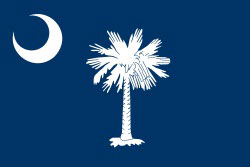Preview of Coming Sectionalist Disaster in 1860-1861
Part 6 of 8 of a Series on the Morrill Tariff
 In 1832, another tariff bill was introduced, supposedly to correct some of the injustices of the 1828 Tariff of Abominations and to give some relief to the South. The 1828 Tariff had also produced a surplus of government income that many wanted to correct. However, the Northern beneficiaries of high tariffs succeeded in a bill that did not diminish their profit margins. Some of the abominations of the 1828 Tariff were relieved, notably the troubling “minimum” provisions, which caused unjust aberrations in the duties and invited fraud. The average dutiable rate was about 33 percent. The net relief to the South, however, was negligible, and many Southern Congressmen felt they had been betrayed and exploited by Northern political interests again.41
In 1832, another tariff bill was introduced, supposedly to correct some of the injustices of the 1828 Tariff of Abominations and to give some relief to the South. The 1828 Tariff had also produced a surplus of government income that many wanted to correct. However, the Northern beneficiaries of high tariffs succeeded in a bill that did not diminish their profit margins. Some of the abominations of the 1828 Tariff were relieved, notably the troubling “minimum” provisions, which caused unjust aberrations in the duties and invited fraud. The average dutiable rate was about 33 percent. The net relief to the South, however, was negligible, and many Southern Congressmen felt they had been betrayed and exploited by Northern political interests again.41
South Carolina expressed the greatest grievance over continuing economic injustice. Senator Hayne appealed to the protectionist majority, but to no avail:
“I call upon gentlemen on the other side of the House to meet us in the true spirit of conciliation and concession. Remove, I earnestly beseech you, from among us, this never-failing source of contention. Dry up, at its source, this fountain of the waters of bitterness. Restore the harmony, which has been disturbed, that mutual affection and confidence which has been impaired. And it is in your power to do it this day, by doing equal justice to all.”42
Passage of the 1832 Tariff was viewed by John C. Calhoun, South Carolina, and the cotton-producing Gulf States as an unequivocal message that Southern suffering and Southern rights were of no concern to most Northern political leaders. Protectionist tariffs were political bargains in which powerful political and commercial interests united to enrich themselves at the expense of less powerful regions and commercial interests. Given no relief, the growth of Northern population and political power would mean that outrageous tax burdens would be continually laid upon the South to enrich the North.
President Jackson signed the 1832 Tariff on July 14, 1832, and Calhoun made plans to seek the U.S. Senate seat being vacated by Robert Hayne, who was running for Governor of South Carolina. Meanwhile, he was engaged in the movement in South Carolina to nullify the 1828 and 1832 Tariffs. Calhoun officially resigned as Vice President on December 28, 1832, to fill the Senate seat to which the South Carolina Legislature had elected him on December 12.
In South Carolina, agitation over the 1828 Tariff began in the summer after its signing. State Representative Robert Barnwell Rhett called on the Governor to convene the State Legislature. Appealing to both honor and justice, he called for South Carolina’s leaders to have the courage to resist Federal protectionist tariffs and other unconstitutional acts:
“But if you are so doubtful of yourselves—if you are not prepared to follow up your principles wherever they may lead, to their very last consequence—if you love life better than honor; prefer ease to perilous liberty, awake not! Stir not! —Impotent resistance will add vengeance to your ruin. Live in smiling peace with your insatiable Oppressors and die with the noble consolation that your submissive patience will survive triumphant over your beggary and despair.”43
By the winter of 1831 and spring of 1832, South Carolina’s Governor James Hamilton was conducting rallies and meetings around the state in support of nullification. Calhoun’s Exposition, especially the concept of nullification, created considerable debate, most of it favorable in South Carolina. The state elections of 1832 confirmed that a substantial majority of South Carolina voters favored nullification, and on October 20, 1832, Governor Hamilton called the legislature to a special session to consider and authorize a Nullification Convention. On November 24, the Nullification Convention met and passed an ordinance declaring that the1828 and 1832 tariffs were unconstitutional and unenforceable.
The Convention cited Calhoun’s view that imposing unequal tax burdens for the benefit of special regional or commercial interests was unconstitutional. In the name of the people of South Carolina assembled in convention, the Ordinance of Nullification ordained and declared that the 1828 and 1832 tariff acts:
“…are unauthorized by the Constitution of the United States and violate the true meaning and intent thereof, and are null, void, and no law, nor binding upon this State, its officers or citizens;…and all judicial proceedings which shall be hereafter had in affirmance thereof, are and shall be held utterly null and void…That it shall not be lawful for any of the constituted authorities, whether of this state or of the United States, to enforce the payment of duties imposed by the said acts within the limits of this State from and after the 1st day of February next…”44
The concept and right of Nullification had been established by the Kentucky and Virginia Resolutions of 1798 and 1799, written by Thomas Jefferson and James Madison respectively. Jefferson and Madison argued that each individual state has the power to declare that federal laws are unconstitutional and void. The Kentucky and Virginia legislatures approved the respective resolutions and declared that the Federal Alien and Sedition Acts of 1798, which limited free speech and criticism of the Federal government were unconstitutional. The Kentucky Resolution of 1799 added that when the states determine that a law is unconstitutional, nullification by the states is the proper remedy. This gave strong historical precedence to States’ Rights. No states opposed the Kentucky and Virginia Resolutions at that time.
President Jackson’s rhetoric, however, made it clear that he intended to prevent Nullification by force of arms, telling a visitor from South Carolina that:
“…if a single drop of blood shall be shed there in opposition to the laws of the United States, I will hang the first man I can lay my hands on engaged in such treasonable conduct, upon the first tree I can reach.”45
On December 10, Jackson issued a Proclamation to the People of South Carolina stating:
“I consider, then, the power to annul a law of the United States, assumed by one State, incompatible with the existence of the Union, contradicted expressly by the letter of the Constitution, unauthorized by its spirit, inconsistent with every principle on which it was founded, and destructive of the great object for which it was formed.”46
Robert Hayne, who had resigned from the United States Senate on his election to the office of Governor of South Carolina in December 1832 and who had been a member of the Nullification Convention, gave an answer to the people of South Carolina and to President Jackson in his inaugural address:
“If the sacred soil of Carolina should be polluted by the footsteps of an invader, or be stained with the blood of her citizens, shed in defense, I trust in Almighty God that no son of hers…who has been nourished at her bosom…will be found raising a parricidal arm against our common mother. And even should she stand alone in this great struggle for constitutional liberty…that there will not be found, in the wider limits of the state, one recreant son who will not fly to the rescue and be ready to lay down his life in her defense.”47
Reacting to the threat to their sovereignty, South Carolina mobilized 27,000 men ready to defend their territory and rights in the event of military attack.48
On January 16, Jackson requested that Congress pass a Force Bill to authorize military intervention against South Carolina. However, others, including former supporters of the 1828 Tariff of Abominations, Henry Clay and Martin Van Buren, saw that the only way to avoid the impending clash of arms was compromise and began working on a compromise tariff bill to replace the 1832 Act with terms more amenable to South Carolina and other Southern states. Fortunately, Calhoun was back in the Senate to assist. The Force Bill was tabled by a vote of 30 to 15 in the Senate, and the House Judiciary Committee voted 4 to 3 against it while both the House and Senate worked franticly to come up with what would become the compromise Tariff Act of 1833. Meanwhile, South Carolina had postponed enforcement of Nullification to avoid unnecessary conflict. General terms for the compromise were reached after a private meeting between Clay and Calhoun.
Jackson’s Force bill was passed only after the compromise Tariff had passed by votes of 119 to 85 in the House and 29 to 16 in the Senate, making the Force Bill effectively moot. The 1833 Tariff Act authorized tariff rates to be gradually rolled back by 1842 to the levels of 1816, with dutiable ad valorem rates averaging about 20 percent—this is approximately the level of tariffs before the Morrill Tariff was passed in 1861.49
Many had opposed the concept of nullification in 1833, but the fact is that it forced a rethinking of the unbearable tariff injuries being imposed on the South and resulted in intelligent compromise, just as it was intended to do in the conception of Calhoun. What is shocking is that the lessons of the Nullification Crisis of 1832 and 1833—with its narrowly avoided threat of secession and armed conflict—were forgotten by 1860 when the more populous North again tried to impose unbearable taxes and extreme economic disadvantages on the South for the sake of Northern industrial growth and prosperity.
---------------------------
Abbreviated Foot Notes Part 6 of 8 (FN 41-49)
FN41 Tariff of 1832, Buzzle.com (http://www.buzzle.com/articles/tariff-of1832.html) Last accessed July 19, 2011.
FN42 Spence, p. 174
FN43 Nullification Crisis, Wikipedia. Last accessed December 18, 2021.
FN44 Ordinance of Nullification (South Carolina), November 24, 1832.
(http://www.adena.com/adena/usa/cw/cw207.htm) Last accessed December 18, 2021.
FN45 Nullification Crisis, Wikipedia. .Last accessed December 18, 2021.
FN46 Ibid,
FN47 Ibid
FN48 Ibid.
FN49 Ibid.









 Mike Scruggs is the author of two books: The Un-Civil War: Shattering the Historical Myths; and Lessons from the Vietnam War: Truths the Media Never Told You, and over 600 articles on military history, national security, intelligent design, genealogical genetics, immigration, current political affairs, Islam, and the Middle East.
Mike Scruggs is the author of two books: The Un-Civil War: Shattering the Historical Myths; and Lessons from the Vietnam War: Truths the Media Never Told You, and over 600 articles on military history, national security, intelligent design, genealogical genetics, immigration, current political affairs, Islam, and the Middle East. 



